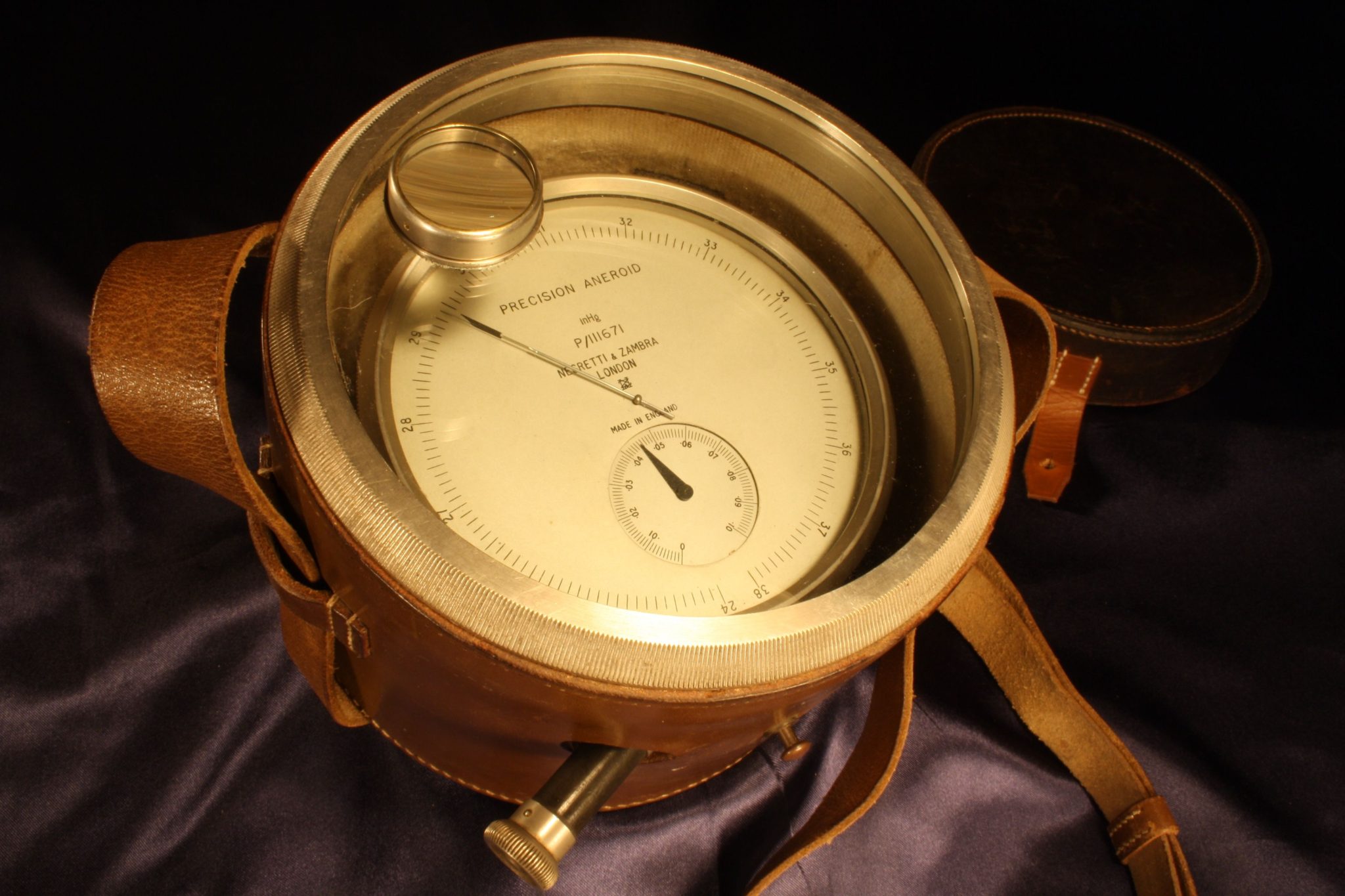Precision mining aneroid altimeter / barometer having die struck and silvered dial with a barometric range from 24” – 38” inches of mercury, the upper portion marked “Precision Aneroid,” “inHg,” serial no. “P/111671,” and maker’s signature “Negretti & Zambra, London” surmounting “NZ” logo, the lower portion further marked “Made in England,” inset subsidiary vernier dial calibrated to 1/100th inches of mercury. Heavy crystal glass contained within substantial bezel. Super lightweight tubular aluminium pointer.
The precision plated bronze movement constructed between twin parallel plates with expansion reliefs, the upper marked no. “109”, opposing twin 2″ hardened steel capsules acting upon a common beam swinging about a leaf spring fulcrum driving an intermediate spindle connected to the main lever. The plates separated on four pillars. The arbour with helically-cut chain guide or fusee and flat section bronze return spring. Vernier adjustment mechanism set below the dial within a sub-assembly. Rack and pinion calibration adjustment, the entire movement rotating within the case and below the dial, all contained within a massive silvered bronze drum form case, the rear with three transport case locating lugs, calibration adjustment port.
The whole contained within a cylindrical hard formed leather transport case having rotating glazed top viewing port with scale magnifier set within a heavy plated bronze bezel. Hard formed leather protecting lid with hold down straps, shoulder strap.
Condition: The subject of a full service, conservation, and calibration under laboratory conditions. Generally good condition, minor dial marks, both instrument and top glass with some cosmetic scratches, compound magnifier with a flaw to one lens. The leather case in generally very sound order, complete with carrying strap. The instrument complete and working.
Comments: An extremely unusual pattern – although a few instruments incorporating this basic movement are known, this is the only one with a subsidiary dial / vernier yet noted. Although conjecture, the only plausible application for this instrument is the survey of the deep mines and, since these were comparatively few in number, this might explain why this instrument is perhaps unique as a survivor of limited production. It might even have been a one off and there are aspects of its execution that might suggest this, notably the outer leather case and rather less than satisfactory rotation of the bezel and loupe / magnifier set in the top outer glass.
This aneroid surveying barometer, designed to measure barometric pressure to 1/100th of an inch, and able to measure heights up to 5000ft and depths to 7000ft below sea level, has been constructed to the very highest standards of any contemporary scientific instrument. A number of notable features are evident: the long evacuation tails on the capsules suggest fine tuning of the capsules whilst the instrument is adjusted for optimum, a feature only seen on one other instrument, the “Experimental Barometer” also showcased on this site that pre-dates this piece and surely formed part of the basic research and design that is manifested in this very fine piece of equipment. (Another feature these two instruments have in common is the mechanical means by which fine adjustment is made for calibration.) Other notable features include expansion relief slots in the main chassis, opposing twin capsule design and, most obviously, the provision of the inset vernier dial enabling extremely accurate readings to be taken. It is likely the basic design of this movement originated in the mid 1930s, and indeed it is mentioned in the maker’s catalogue of 1936 though this instrument would appear to be later, probably 1950s. These instruments were constructed in very small numbers and would have been extremely expensive, the end users possibly being organisations such as the Ordnance Survey, the Armed Forces, mining and civil construction companies.
A Note on Negretti & Zambra P Numbers: Each of these instruments carries two numbers, a dial serial number usually prefixed with a P, and a number struck into the movement chassis. The dial numbers prefixed “P” denote Pressure or possibly Precision measurement, were introduced in 1921, and are from the whole series of such instruments that Negretti & Zambra made over this period. It is very likely that the movement numbers are consecutive and unique to this design.
Of the similar movements examined so far, all are struck with a number. There are at least six different arrangements of these precision altimeter barometers: this mining one, P/111671; four versions of the Isothermal instrument, one of which, numbered 13/43 (no P number, probably dating to 1943), is calibrated in feet, and four later versions almost certainly manufactured in the 1950s, P/ 157780, P/113173, P/113129, P/48888; a straight forward meteorological instrument, P/97080; two further instruments, consecutively numbered P/114165 & P/114166, calibrated in Mb with ranges from 100 – 300 are known – these instruments, manufactured in 1956 for Operation Grapple, were almost certainly primary altimeters stationed in the bomb aimers position of XD 818, the scale indicating an altitude 30,000ft to 55,000ft, the bombs dropped from 45,000ft. These last two instruments have black dials, the scales printed in white, and are marked Port and Starboard Static – they are perhaps the most fascinating and historically interesting altimeters one could imagine.
Dimensions: 7″ diameter x 6″ high
Stock No: BA0429
Price: Vavasseur Archive - not currently for sale


